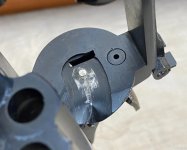Handgunner00
SWCA Member
Considering a vintage 27-2 with flawless bluing and a nearly invisible, hair thin cylinder turn line. Seller/collector opines this 27-2 may only have been factory test fired. But there is about a half inch streak through the center of the recoil shield that is down to the steel. See attached pic. Would it take more than test firing to produce this streak, or would test firing be enough?
Thanks.
Thanks.

